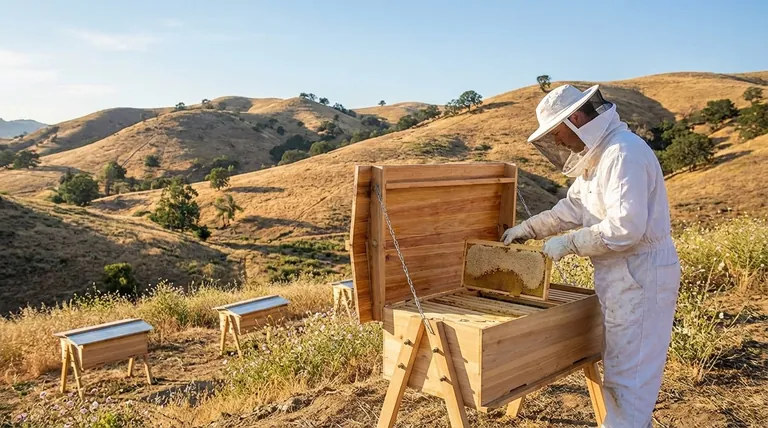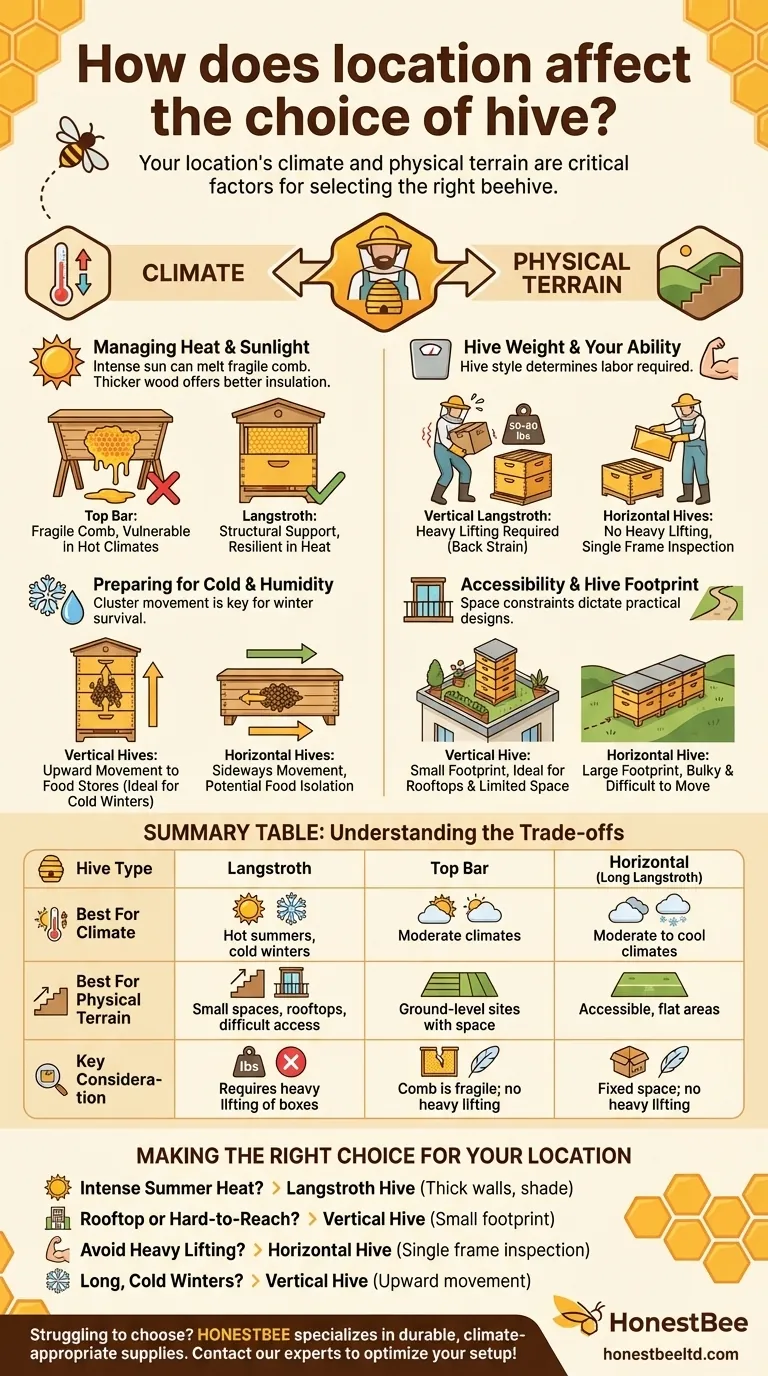Your location's climate and physical terrain are two of the most critical factors in selecting the right beehive. Choosing a hive that is mismatched to your environment can lead to significant challenges, from bees overheating to major difficulties in hive management. For instance, a Top Bar hive with its free-hanging comb can be vulnerable in very hot climates, while a bulky horizontal hive is impractical for a rooftop or a location with difficult physical access.
Choosing a hive is not just about a particular beekeeping philosophy; it's a practical decision based on physics and biology. The hive must be compatible with your local climate and the physical constraints of your apiary site to ensure both the health of the colony and your ability to manage it effectively.

Matching Hive Design to Your Climate
A beehive is your colony's shelter against the elements. Its design directly impacts how well the bees can regulate their internal temperature and humidity, which is fundamental to their survival.
Managing Heat and Sunlight
All bees benefit from morning sun to get them active, but intense, all-day sun in a hot climate can be dangerous. The hive's design plays a major role in mitigating this heat stress.
Top Bar Hives, which use bars rather than full frames, encourage bees to build their own comb that hangs freely. This comb is fragile and can melt and collapse in extreme heat, destroying the colony's brood and food stores.
Langstroth hives, with their four-sided wooden frames, provide significantly more structural support to the comb. This makes them a more resilient choice for locations with very hot summers. Thicker wooden components also offer better insulation against heat.
Preparing for Cold and Humidity
In colder climates, the bee cluster's ability to stay warm and access food is paramount. This is where hive orientation—vertical versus horizontal—becomes a key consideration.
Vertical hives, like the Langstroth or Warre, allow the bee cluster to move upward as a single unit, following their natural instinct to consume honey stores above them throughout the winter.
Horizontal hives, such as Top Bar or Long Langstroth hives, require the cluster to move sideways. This can sometimes isolate the bees from their food stores, potentially requiring the beekeeper to move frames of honey closer to the cluster mid-winter.
The Physical Realities of Your Apiary Location
Beyond climate, the actual physical space where you place your hive will dictate which designs are practical and which are simply unworkable.
Hive Weight and Your Physical Ability
Beekeeping can be physically demanding, and the hive style is the single biggest factor in the type of labor required.
Vertical Langstroth hives require you to lift heavy boxes (supers) that can weigh anywhere from 50 to 80 pounds (23-36 kg) when full of honey. This is a significant consideration for anyone with back problems or limited physical strength.
Horizontal hives completely eliminate heavy lifting. In a Top Bar or Long Langstroth, you only ever lift one frame at a time, which weighs just a few pounds. This makes them an excellent choice for beekeepers who cannot or do not want to perform heavy lifting.
Accessibility and Hive Footprint
Consider the path you must take to get to your hives. Is it up a flight of stairs, on a small balcony, or across a steep hill?
A sprawling horizontal hive has a large footprint and is bulky and difficult to move. It is a poor choice for small spaces or locations with difficult access, like an urban rooftop.
A vertical hive has a much smaller footprint, making it ideal for apiaries where ground space is limited. Its modular components are also easier to carry to a challenging location one piece at a time.
Understanding the Trade-offs
No single hive is perfect for every situation. Choosing the right one means understanding the inherent compromises of each design.
The Horizontal Hive: Ease vs. Finite Space
Horizontal hives are exceptionally easy to manage from a physical standpoint, as they require no heavy lifting. However, their volume is fixed. A booming colony can run out of space, which can limit honey production and increase the likelihood of swarming.
The Vertical Hive: Standardization vs. Heavy Lifting
The Langstroth hive is the global standard. This makes finding equipment, parts, and educational resources incredibly easy. Its key trade-off is the back-breaking work of lifting heavy supers during inspections and honey harvests.
The Top Bar Hive: Natural Comb vs. Fragility
Top Bar Hives are prized by beekeepers who want to promote natural, foundationless comb. The primary downside is that this comb is fragile, cannot be spun in a standard honey extractor, and is more susceptible to collapse in high heat.
Making the Right Choice for Your Location
Your final decision should be a pragmatic one that balances bee health with your own physical and environmental realities.
- If your primary challenge is intense summer heat: Consider a well-ventilated, thick-walled Langstroth hive and be sure to provide some afternoon shade.
- If your apiary is on a rooftop, balcony, or hard-to-reach area: A vertical hive (Langstroth or Warre) with its small footprint is a more practical choice than a bulky horizontal hive.
- If your primary goal is to avoid heavy lifting due to physical limitations: A horizontal hive (Top Bar or Long Langstroth) is the superior choice, as you only inspect one frame at a time.
- If your location has long, cold winters: A vertical hive better supports the colony's natural instinct to move upward toward its food stores.
By carefully matching your hive choice to your specific location, you create the best possible foundation for a healthy colony and a successful beekeeping journey.
Summary Table:
| Hive Type | Best For Climate | Best For Physical Terrain | Key Consideration |
|---|---|---|---|
| Langstroth | Hot summers, cold winters | Small spaces, rooftops, difficult access | Requires heavy lifting of boxes |
| Top Bar | Moderate climates | Ground-level sites with space | Comb is fragile; no heavy lifting |
| Horizontal | Moderate to cool climates | Accessible, flat areas | Fixed space; no heavy lifting |
Struggling to choose the right hive for your apiary's unique conditions? HONESTBEE specializes in supplying durable, climate-appropriate beekeeping supplies and equipment to commercial apiaries and distributors. Whether you need heat-resistant Langstroth hives for scorching summers or lightweight horizontal options for easy management, our wholesale-focused operations ensure you get reliable gear tailored to your location. Contact our experts today to optimize your hive setup for healthier bees and a smoother beekeeping season!
Visual Guide

Related Products
- Long Langstroth Style Horizontal Top Bar Hive for Wholesale
- Langstroth Bee Hives Bee Keeping Box for Beginners Beekeeping
- Top Bar Beehive for Beekeeping Wholesales Kenya Top Bar Hive
- Wholesales Dadant Size Wooden Bee Hives for Beekeeping
- HONESTBEE Advanced Ergonomic Stainless Steel Hive Tool for Beekeeping
People Also Ask
- What are the box management requirements for a top bar hive vs. Langstroth? Choose Your Hive Strategy
- What are the benefits of the top bar hive? A Guide to Ergonomic, Natural Beekeeping
- What are the advantages of a top bar hive? Simpler, Bee-Centric Beekeeping for All
- What is a top bar bee hive? A Natural, Low-Stress Beekeeping Solution
- How does the top bar hive help control varroa mites? A Natural Approach to Mite Management



















